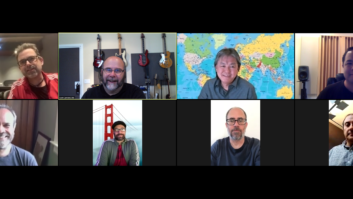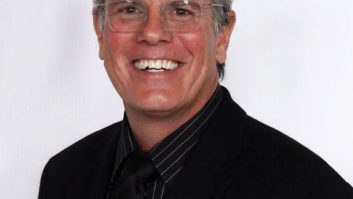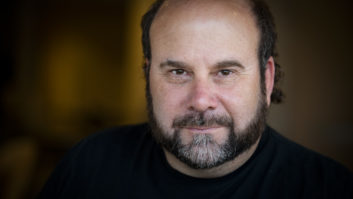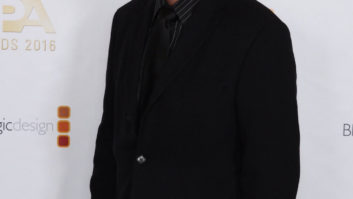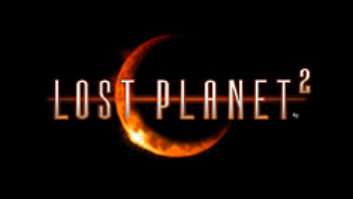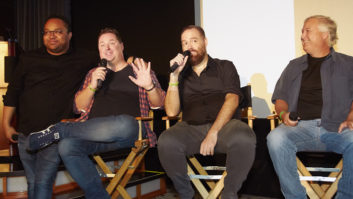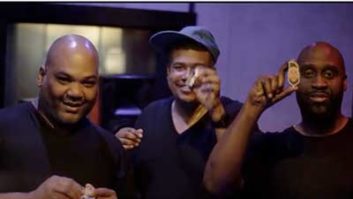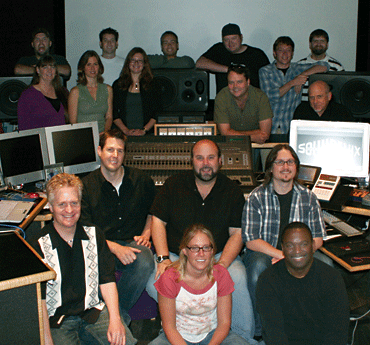
In our June issue, we profiled Technicolor Interactive, one of many studios providing services to games and interactive entertainment. This month, we take a look at another well-known facility: Soundelux, specifically Soundelux Design Music Group. I had the opportunity to speak with Scott Gershin, Marc Aramian, William “Chip” Beaman and Bryan Celano about the group’s humble beginnings and current impressive list of clients, as well as its game-specific audio integration techniques.
The hardworking, tightknit crew at Soundelux DMG centered around Scott Gershin in his sound creation/mix room.
How did DMG start and what is its relationship with Soundelux?
Beaman: Soundelux Design Music Group [formerly known as Soundelux Media Labs] was started in 1991 by Scott Gershin, who at the time was lead sound designer at Soundelux in Hollywood. With the backing of Wylie Stateman and Lon Bender, Scott was able to assemble an array of talented people who had to break the norms of how things were done and come up with new approaches and techniques to a brand-new industry.
Gershin: I had a vision to create a “Sound Designer and Composer Think Tank” that incorporated many of the creative approaches used in film post sound. Each Soundelux DMG designer combined those techniques, along with the high level of audio expertise found in the recording industry and their knowledge of synthesis technology. We focused those disciplines to work concurrently in the then-infant game sound industry since most of the sound and music found in games at that time was created using FM synthesis.
What percentage of DMG’s projects are games?
Gershin: Soundelux Design Music Group is the interactive entertainment arm of Soundelux, which is an Ascent Media company. We have an army of sound designers, composers, re-recording mixers, integrators, voice-over directors, managers and coordinators. Games make up about 80 percent of our projects. We also work on commercials and location-based entertainment, such as T2 3D, Jurassic Park and the Kennedy Space Center shuttle-simulator attraction.
Scott, you’re a member of the Game Audio Network Guild and co-chair for the Interactive Entertainment Sound Developers branch. How is DMG involved with this effort?
Gershin: The GANG:IESD group was started by myself and Gene Semel of Sony Entertainment. [At the time of the initial gathering, Semel was working at High Moon Studios.] We decided to get together and throw a networking party where sound designers had a chance to show off what they had been working on or just talk and share ideas. After that initial gathering, Gene and I recruited David Murrant of Sony and Scott Selfon of Microsoft, and the idea just kept growing from there. Some of the supervising sound designers have also been asked to join the board of directors for the Los Angeles-area group. [Eds. Note: The IESD was officially launched last month with an announcement at Ex’pression College for Digital Arts, a G.A.N.G. program partner. For more, visit
www.audiogang.org.)
On what projects has Soundelux done real-time mixing?
Gershin: It is a best-case scenario when a client asks us to be involved in implementation and in-game mixing, as well as sound design. It is crucial to listen to the sounds we have created in context to make sure they are having the desired emotional effect, as well as sort out any problems with how they blend or clash with other sounds. Hearing the game come alive also inspires us to add new sounds or change existing sounds, in the same way feature-film sound editors add “sweeteners” during the mix.
We have been fortunate to work with producers and audio directors who want to spend time making sure all the hard work put into the sound design, music composition and voice-over translates into a great-sounding mix. One thing we contribute to in-game mixing is our experience being at the mix for so many movies.
Describe your gear setup in the different rooms and how it interfaces with game audio specifically?
Aramian: We’ve created a studio environment from the ground up that is geared toward the gaming world. We built design suites to simulate the average space a gamer may play in [most are 18×16 feet]. All of our designers and composers extensively and continually research the best tools for game design.
Celano: All of our in-house design suites are equipped with Pro Tools HD and FMOD running on Mac OS X, as well as dedicated Windows machines running a multitude of middleware, including WWise, FMOD, XACT and other proprietary programs we can’t talk about. We have a developer partnership with WWise, which opens a dialog between our designers and the software programmers.
Gershin: Our editing systems are connected to the Ascent Media Network — the same system that also connects all of Ascent Media’s facilities, including the Todd-AO ADR and Foley stages. This gives Soundelux DMG the ability and flexibility to use the same facilities as our film and TV groups. We can shoot Foley at any one of our Foley stages [Santa Monica, Burbank and Hollywood], record ADR at several of DMG’s VO stages, capture/record facial MoCap and bring in A-list Hollywood talent. Soundelux also has access to the family of Ascent Media studios and facilities around the world [New York, Atlanta, London and Singapore, to name a few].
Beaman: We also have access to a growing roster of composers, including Chris Tin, who wrote “Baba Yetu” for Civilization IV. Some composers are in-house, some off-site, so we can provide steady delivery of assets that can also be mixed with other assets on the same project before delivery to the client.
What is the most recent project that you would consider the most innovative to work on from an audio standpoint?
Gershin:
Lost Planet was done in 5.1, and because the sounds follow the physics of the game accurately, many Japanese gamers bought 5.1 systems. There was quite a buzz out there on the game forums about how cool it was to have a rocket whiz right by your head and hit something behind you.
We’re currently working on a huge karaoke game, whose name I can’t mention, that required producing the vocals on 30 songs using contemporary pop techniques: massive multitracking, pitch correction, multiple miking setups, et cetera. Two gamers can pick and choose whose part they will be singing. The remaining parts are mixed as stems in-game. The PlayStation 3 console mixes the live vocals with the chosen tracks and grades the singers on both pitch and timing.
Are there any projects you’ve done lately for VO music and/or SFX in which the games only use 44.1kHz/16-bit or higher formats? Any games using 96 kHz?
Aramian: Several years ago, Soundelux started to record all of our sound libraries at 96k/24-bit and some at 192k/24-bit. In fact, all of the Hollywood Edge libraries represent about three percent of our total in-house library. When we mix and master our sound design, music, VO and cinematics, we are always at 24-bit; if needed, we can convert our files to 16-bit. We always work at the highest-possible resolution and only convert at the last step. As far as sample rates go, we are mostly at 48k, but occasionally work at other sample rates such as 96k and 44.1k. We will work with lower sample rates on specific projects like mobile games. We haven’t worked on any games that use 96kHz files in the finished product; 48k/16-bit seems to be the standard now. Instead of using lower sample and bit rates, developers are using data compression to save memory.
What percentage of your work would you say is done in surround?
Gershin: Most of our cinematic work is done in 5.1 and stereo-encoded formats [Dolby Pro Logic, PL, PL2]. We are designing with surrounds in mind, both for in-game and cinematics. We have mastered music mixes in both formats. We like to master and deliver cinematics in 5.1 so the client has more options.
Alexander Brandon is the audio director at Obsidian Entertainment.
